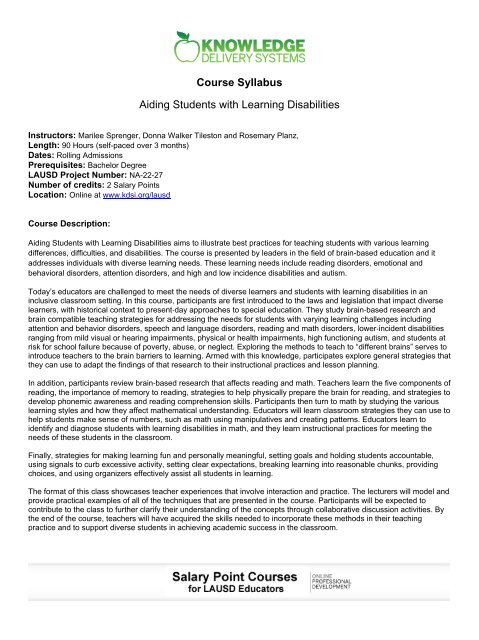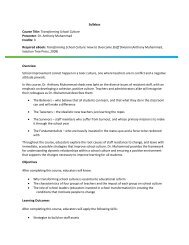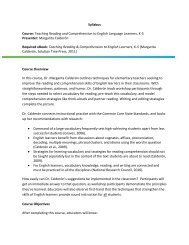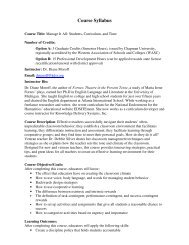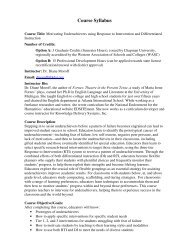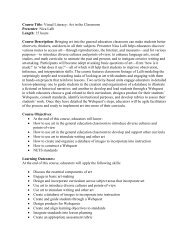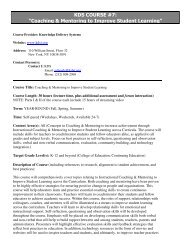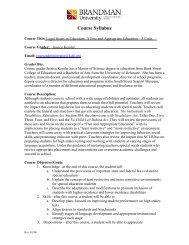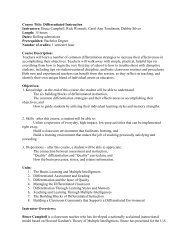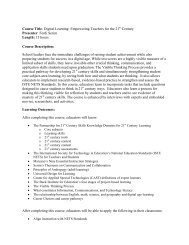Course Syllabus Aiding Students with Learning Disabilities
Course Syllabus Aiding Students with Learning Disabilities
Course Syllabus Aiding Students with Learning Disabilities
Create successful ePaper yourself
Turn your PDF publications into a flip-book with our unique Google optimized e-Paper software.
<strong>Course</strong> <strong>Syllabus</strong><br />
<strong>Aiding</strong> <strong>Students</strong> <strong>with</strong> <strong>Learning</strong> <strong>Disabilities</strong><br />
Instructors: Marilee Sprenger, Donna Walker Tileston and Rosemary Planz,<br />
Length: 90 Hours (self-paced over 3 months)<br />
Dates: Rolling Admissions<br />
Prerequisites: Bachelor Degree<br />
LAUSD Project Number: NA-22-27<br />
Number of credits: 2 Salary Points<br />
Location: Online at www.kdsi.org/lausd<br />
<strong>Course</strong> Description:<br />
<strong>Aiding</strong> <strong>Students</strong> <strong>with</strong> <strong>Learning</strong> <strong>Disabilities</strong> aims to illustrate best practices for teaching students <strong>with</strong> various learning<br />
differences, difficulties, and disabilities. The course is presented by leaders in the field of brain-based education and it<br />
addresses individuals <strong>with</strong> diverse learning needs. These learning needs include reading disorders, emotional and<br />
behavioral disorders, attention disorders, and high and low incidence disabilities and autism.<br />
Today’s educators are challenged to meet the needs of diverse learners and students <strong>with</strong> learning disabilities in an<br />
inclusive classroom setting. In this course, participants are first introduced to the laws and legislation that impact diverse<br />
learners, <strong>with</strong> historical context to present‐day approaches to special education. They study brain‐based research and<br />
brain compatible teaching strategies for addressing the needs for students <strong>with</strong> varying learning challenges including<br />
attention and behavior disorders, speech and language disorders, reading and math disorders, lower‐incident disabilities<br />
ranging from mild visual or hearing impairments, physical or health impairments, high functioning autism, and students at<br />
risk for school failure because of poverty, abuse, or neglect. Exploring the methods to teach to ―different brains‖ serves to<br />
introduce teachers to the brain barriers to learning. Armed <strong>with</strong> this knowledge, participates explore general strategies that<br />
they can use to adapt the findings of that research to their instructional practices and lesson planning.<br />
In addition, participants review brain‐based research that affects reading and math. Teachers learn the five components of<br />
reading, the importance of memory to reading, strategies to help physically prepare the brain for reading, and strategies to<br />
develop phonemic awareness and reading comprehension skills. Participants then turn to math by studying the various<br />
learning styles and how they affect mathematical understanding. Educators will learn classroom strategies they can use to<br />
help students make sense of numbers, such as math using manipulatives and creating patterns. Educators learn to<br />
identify and diagnose students <strong>with</strong> learning disabilities in math, and they learn instructional practices for meeting the<br />
needs of these students in the classroom.<br />
Finally, strategies for making learning fun and personally meaningful, setting goals and holding students accountable,<br />
using signals to curb excessive activity, setting clear expectations, breaking learning into reasonable chunks, providing<br />
choices, and using organizers effectively assist all students in learning.<br />
The format of this class showcases teacher experiences that involve interaction and practice. The lecturers will model and<br />
provide practical examples of all of the techniques that are presented in the course. Participants will be expected to<br />
contribute to the class to further clarify their understanding of the concepts through collaborative discussion activities. By<br />
the end of the course, teachers will have acquired the skills needed to incorporate these methods in their teaching<br />
practice and to support diverse students in achieving academic success in the classroom.
Objectives:<br />
Participants will apply the following skills:<br />
Understand the workings of a student’s brain and the learning difficulties encountered by students <strong>with</strong> specific<br />
disabilities<br />
Serve students <strong>with</strong> formerly ―misunderstood minds‖ in order to encourage enhanced academic performance and<br />
increased confidence and contribution to classroom activities<br />
Analyze learning problems and provide strategies to solve those problems<br />
Differentiate instruction to meet the needs of students <strong>with</strong> different brains<br />
Use strategies for students <strong>with</strong> specific needs due to learning disabilities<br />
Analyze student differences and design instruction that will meet the needs of most learners and create specific<br />
strategies for those students who need them<br />
Apply best practices from brain research to engage different learners in the learning process<br />
Understand brain development from early childhood through adolescence<br />
Understand current brain research and have the ability to teach in a brain‐compatible manner<br />
Recognize patterns and behaviors associated <strong>with</strong> different brains and teach to those patterns and behaviors<br />
Use brain‐compatible methods of assessment appropriate for students <strong>with</strong> different abilities or disabilities<br />
Understand brain patterns and how to use optimal learning times<br />
Understand and teach to the different brains<br />
Develop and utilize educational strategies for different brains<br />
Augment literacy and math skills to meet state and national standards<br />
Presenter Overview<br />
Marilee Sprenger: An educational neuroscience consultant, Marilee Sprenger has taught pre-kindergarten to graduate<br />
school and now teaches brain-compatible strategies and memory courses as an adjunct professor at Aurora University. A<br />
member of the American Academy of Neurology, the Cognitive Neuroscience Society, and the <strong>Learning</strong> and Brain<br />
Society, as well as of many education organizations such as Association for Supervision and Curriculum Development<br />
and Phi Delta Kappa, she is the author of <strong>Learning</strong> and Memory: The Brain in Action, Becoming a Wiz at Brain-based<br />
Teaching; Differentiation through <strong>Learning</strong> Styles and Memory;and How to Teach So <strong>Students</strong> Remember. Sprenger<br />
assists schools by translating and aiding in the application of current educational neuroscience and memory research.<br />
Donna Walker Tileston: Donna Walker Tileston's ten-book collection, What Every Teacher Should Know, received the<br />
2004 Distinguished Achievement Award for Excellence in Educational Publishing by the Association of Educational<br />
Publishers. She has served education as a leader in teaching, administration, research, writing, software development,<br />
national consulting, curriculum development, management, technology, finance, grants management, public relations, and<br />
drug abuse prevention programs. Dr. Tileston now specializes in brain research and the factors that inhibit learning or<br />
increase the brain's ability to put information into long-term memory. To date Dr. Tileston has made over 500<br />
presentations on her research and materials at state, national, and international conferences, notably at The Hague in<br />
November, 2005, and in Prague in March, 2006.<br />
Rosemary Planz: Rosemary S. Planz has a B.S. and Ed. M. in elementary education from SUNY Buffalo. Certified in<br />
New York in special education and elementary school teaching, as well as school district and educational administration,<br />
she has also pursued additional coursework in computer technology and telecommunications. She served the Hicksville<br />
public school system as a teacher and administrator for over two decades, and has also been an adjunct professor,<br />
assistant superintendent, sales representative, and department director. The winner of three awards from the Hicksville<br />
Counsel of PTA's, Planz specializes in the legal issues surrounding the education of students <strong>with</strong> educational disabilities,<br />
<strong>with</strong> a focus on how the student's entire community can collaborate to construct effective learning environments.
Methods of instruction will include<br />
Individual units (20) are arranged as follows:<br />
Step 1: Objective – Each unit starts <strong>with</strong> an objective which provides and overview, outline and detailed<br />
objectives describing the skills educators will be taking from the lesson. Participants must read the objective<br />
before moving on <strong>with</strong> their coursework.<br />
Step 2: Critical Thinking: Pre-work – This pre-assessment is in the form of multiple choice and open-ended<br />
questions and is to be completed prior to playing the lecture. The purpose of the pre-assessment is to engage the<br />
participant, provoke thought and measure their knowledge of the unit content as they begin each lesson. This can<br />
later be used for reflection and self assessment. While this step, like all others, is required to receive a passing<br />
grade, an incorrect answer in the pre-assessment will not negatively impact your score. Participants must answer<br />
the questions in a thoughtful manner to the best of their ability. Answers such as ―I don’t know‖ will not be<br />
accepted as participants are not graded on the accuracy of their answer.<br />
Step 3: Video/audio lecture – Participants will watch/listen to lectures <strong>with</strong> accompanying PowerPoint<br />
presentations. Participants may take and save notes online, download PowerPoint slides and any available<br />
handouts or resources. All lectures must be played in full to receive credit. While a transcript of the lecture is<br />
available online, it is a supplemental tool for studying and following along <strong>with</strong> the lecture and is not intended as a<br />
replacement for the actual classroom instruction time provided by the lecture. Lectures can be played multiple<br />
times.<br />
Step 4: Critical Thinking: Post-work – This post lecture assessments is in the form of multiple choice and<br />
open-ended questions and is to be completed prior to playing the lecture. The purpose of the pre-assessment is<br />
to gauge the knowledge of the participant and to assess the skills they have taken from the lesson. Unlike the<br />
pre-assessment, participants will be scored and this will be counted as part of their overall courses grade.<br />
Participants must answer the questions in a thoughtful manner to the best of their ability.<br />
Step 5: Journal – Each unit requires a journal entry. Participants will be asked to reflect on the pedagogical<br />
strategies from the lecture and how they apply to your classroom or students, their experience implementing the<br />
strategies or to explain how you plan to integrate the strategies into your classroom. Answers may be brief but<br />
should be at least a 3 to 5 sentences and no more than 7,000 characters<br />
Step 6: Discussion – Participants will engage <strong>with</strong> their colleagues and forum administrator to discuss the lessons<br />
and exchange ideas. Participants must make 2 posts to the discussion forum for each unit. These posts may<br />
be in the form of responses to topics posted by other participants or may be their own original post or question.<br />
Please refrain from posting technical support or credit redemption questions in the discussion forum as it is<br />
facilitated by curriculum experts and not the customer support team.<br />
All steps listed under each unit must be completed to receive credit for the course. No partial credit will<br />
be given.<br />
Texts and/or Other Materials:<br />
Transcripts<br />
Handouts<br />
PowerPoint presentations
List of Units (20):<br />
1) Brain Structure and Development Marilee Sprenger<br />
In this session, educational neuroscience consultant Marilee Sprenger will cover the biology of the brain as it applies<br />
to education. This session provides information on structure, development, and function of the human brain. From the<br />
cellular level to the hemispheres of the brain, participants will become familiar <strong>with</strong> the functioning of the normal brain.<br />
Sprenger also covers enrichment, windows of opportunity, and the learning disabled brain.<br />
2) Brain-Compatible Teaching Principles Marilee Sprenger<br />
In this session, author and consultant Marilee Sprenger covers myths and mysteries of the brain as they apply to the<br />
classroom. She then discusses brain compatible teaching principles and provides practical examples. The session will<br />
offer teachers the opportunity to consider their classrooms and teaching styles in regard to how the brain learns.<br />
3) Wiring the Brain for Literacy Marilee Sprenger<br />
In this session, neuroscience consultant Marilee Sprenger discusses literacy in regard to brain structure and function.<br />
She explains and provides examples of the five reading components. She also explores the importance of memory to<br />
reading, and finally she offers strategies to help physically prepare the brain for reading.<br />
4) A Free and Appropriate Education Donna Walker Tileston<br />
In this session, Dr. Tileston presents a comprehensive overview of the laws that govern special education. She begins<br />
by providing some historical context to present-day approaches to special education. In the main portion of the<br />
session she reviews the federal and state laws that govern special education: IDEA, Section 504, the Americans <strong>with</strong><br />
<strong>Disabilities</strong> Act, Titles One, Two, Three, Four, and Five, and the NCLB Act. She discusses the provisions of each of<br />
these acts in detail, <strong>with</strong> a focus on how they affect the education of children <strong>with</strong> special needs. Next, she considers<br />
the notion of a "Free and Appropriate Education" and the ideas of Least Restrictive and More Restrictive<br />
Environments as these apply to the types of special education services schools are required to provide. She<br />
concludes by offering suggestions for what schools can do to implement special education programs that meet the<br />
standards set down in federal and state laws.<br />
5) Special Education and the Brain: Part 1 Donna Walker Tileston<br />
In this session, Dr, Tileston discusses how the brain works and how understanding the functioning of the brain can<br />
help teachers and others understand how their students, both special education students and others, learn. She<br />
begins by considering what it means to be "smart" and then contrasts "smart" learners <strong>with</strong> "slow" learners. The<br />
former can learn using all memory pathways. Slow learners must be taught in their preferred modality if they are to<br />
learn.<br />
6) Special Education and the Brain: Part 2 Donna Walker Tileston<br />
In this session, Dr. Tileston discusses brain research and special education. She focuses on the third of the three<br />
brain systems— the cognitive system. She draws a distinction between declarative knowledge — knowledge that we<br />
recall — and procedural knowledge — what we are able to do <strong>with</strong> what we know. Her discussion of declarative<br />
knowledge focuses on the use of a variety of organizers — effective tools that can help students increase their ability<br />
to recall and organize pieces of information. In her discussion of procedural knowledge, Dr. Tileston focuses on what<br />
students will be able to do <strong>with</strong> the information they can recall (their declarative knowledge). Our goal as teachers,<br />
she suggests, should be to help students learn how to construct a variety of mental models — e.g., compare and<br />
contrast, sequence, etc. In her view, the overall goal should be automaticity.
7) Attention Disorders Donna Walker Tileston<br />
In this topic, Dr. Tileston focuses on attention disorders: Attention-Deficit Hyperactivity Disorder (ADHD) and Attention<br />
Deficit Disorder (ADD). She begins by offering a discussion and definition of ADHD. This condition, she suggests, has<br />
three components: inattention, hyperactivity, and impulsivity. She considers the causes and diagnosis of this disorder.<br />
She also offers a brief discussion of ADD and its differences from ADHD. Dr. Tileston considers some of the ways that<br />
schools and teachers contribute to student inability to stay attentive. She asks participants to consider the affect of<br />
particular styles of teaching (lectures), room arrangements, inconsistent rules, tense classroom climates, and the<br />
failure to engage students as contributory factors to the inability of students to stay focused.<br />
8) Attention Solutions Donna Walker Tileston<br />
In this session, Dr. Tileston considers in detail some strategies teachers can use to address student attention<br />
difficulties. She begins by providing a detailed analysis of a sample unit, focusing on how it draws on prior knowledge<br />
of the student and uses strategies that make the learning of the lesson personally relevant. She also discusses how<br />
the sample unit draws on the idea of multiple intelligences and different learning modalities as well as ways to add<br />
complexity to the lesson as it progresses.<br />
9) Emotional and Behavior Disorders Donna Walker Tileston<br />
In this topic, Dr. Tileston addresses the issue of emotional and behavioral disorders. She begins by considering the<br />
power of emotions and the ways that the brain controls emotions. She considers anxiety disorders and explores the<br />
characteristics and causes of each. She then explores depressive disorders and briefly a variety of other emotional<br />
disorders.<br />
10) Autism Donna Walker Tileston<br />
In this topic, Dr. Tileston addresses autism. She begins by providing a basic definition of autism and some facts about<br />
its frequency. She also addresses current thinking about what does and what does not cause autism, and what can<br />
be done to treat this disorder. She then turns her attention to one variety of autism — Asperger's Syndrome, a type of<br />
high functioning autism. She contrasts children (and adolescents) <strong>with</strong> autism to those <strong>with</strong> Asperger's and offers<br />
some thoughts on the causes of the latter.<br />
11) Speech and Language Disorders Donna Walker Tileston<br />
In this topic, Dr. Tileston considers the issue of speech and language disorders. She provides an account of the<br />
history of research on language and speech disorders beginning <strong>with</strong> the work of Paul Broca in the mid-19 th century.<br />
Next, she addresses the current understanding of language development in children the first six years of life. This<br />
section of the presentation presents a very comprehensive overview of the stages of normal language development.<br />
Dr. Tileston considers a number of specific language disorders and concludes by offering some thoughts on what<br />
teachers can do to help students who present language disorders.<br />
12) Reading Disorders Donna Walker Tileston<br />
In this topic, Dr. Tileston considers the issue of reading disorders. She begins by providing an account of research on<br />
reading disorders and the differences between male and female brain development. Next, she addresses the current<br />
understanding of how one learns to read and what can go wrong. Dr. Tileston considers specific reading disorders<br />
such as Phonological Alexia, and the broader term for many language disorders, Dyslexia. She concludes by offering<br />
strategies that educators can use to help students <strong>with</strong> reading disorders develop phonemic awareness and reading<br />
comprehension skills.
13) <strong>Learning</strong> <strong>Disabilities</strong> in Mathematics Donna Walker Tileston<br />
In this topic, Dr. Tileston considers learning disability in mathematics. She begins by providing an overview of the<br />
many deficits that can cause problems <strong>with</strong> mathematical ability. She then covers current research and how various<br />
learning styles affect mathematical understanding. Next, she addresses how best to diagnose disabilities in<br />
mathematics. She offers classroom strategies educators can use to help students make connections, such as math<br />
manipulatives and creating patterns. She concludes by offering guidelines for educators on how to best meet the<br />
needs of students <strong>with</strong> learning disabilities in mathematics.<br />
14) Introduction to Inclusive Teaching Rosemary Planz<br />
The goal of this session is to introduce participants to the educational rights of students who have educational<br />
disabilities and to the legal foundations that support students in the schools. Participants will become familiar <strong>with</strong> the<br />
issues surrounding inclusion and IDEA and the concepts of the least-restrictive environment. Participants will identify<br />
the differences between mainstreaming and full inclusion and some pros and cons surrounding full inclusion of<br />
students in general education classrooms. Discussions of the different types of disabilities and classifications that are<br />
served under IDEA along <strong>with</strong> the models of service delivery will help participants understand the different levels of<br />
services provided to students along the special education continuum of services.<br />
15) Collaboration: Partnerships and Procedures Rosemary Planz<br />
The goal of this session is to have students understand that the IDEA law provides legal rights, but for the law to be<br />
effective, collaboration and constructive partnerships must be established among parents, teachers, school<br />
specialists, administrators, and community agencies. Both the school and parents must accept certain basic<br />
responsibilities, and to meet these responsibilities, parents and school personnel must engage in problem-solving<br />
strategies, working together to devise procedures necessary for identification, referral, assessment, and placement<br />
processes to accommodate students <strong>with</strong> special needs and other at-risk students. This session will review the<br />
responsibilities, and procedures that have been set up to facilitate intervention strategies, referral to special education,<br />
and suggestions for working <strong>with</strong> staff and parents.<br />
16) Teaching <strong>Students</strong> <strong>with</strong> High-Incidence <strong>Disabilities</strong> Rosemary Planz<br />
The goal of this session is to introduce participants to the disability categories that are more frequently found in the<br />
public school setting. Higher-incidence disabilities include a wide variety of abilities and disabilities that may be mild to<br />
severe in intensity. Some are temporary, while others are lifelong conditions. Higher-incidence disabilities include<br />
speech and language impairments, learning disabilities, mild or moderate mental retardation, and emotional or<br />
behavioral disorders. Together these disability areas make up about 90% of the total population of students ages 6 to<br />
21 <strong>with</strong> disabilities served under IDEA.<br />
17) Teaching <strong>Students</strong> <strong>with</strong> Low-Incidence <strong>Disabilities</strong> Rosemary Planz<br />
In this session participants will learn the characteristics of students <strong>with</strong> lower-incidence disabilities. These students<br />
are far less commonly represented in schools than students <strong>with</strong> higher-incidence disabilities. <strong>Students</strong> <strong>with</strong> less<br />
common disabilities may have been born <strong>with</strong> them or acquired them later in life, and they may be mild to severe.<br />
Some may be temporary; others are permanent or even life threatening. Lower-incidence disabilities include visual<br />
impairments, hearing impairments, physical and other health impairments, severe and multiple disabilities, and<br />
autism. Many creative adaptations have been made in general education classrooms in order to accommodate these<br />
students so that they can be educated <strong>with</strong> non-disabled peers.
18) Individuals <strong>with</strong> Other Diverse <strong>Learning</strong> Needs & Effective Instruction for All <strong>Students</strong> Rosemary Planz<br />
In this session participants will learn the characteristics of students <strong>with</strong> diverse learning needs. Not all students <strong>with</strong><br />
diverse or special learning needs are classified as disabled. <strong>Students</strong> <strong>with</strong> other special learning needs represent a<br />
wide range of abilities and include:<br />
<strong>Students</strong> from different cultural and linguistic backgrounds<br />
<strong>Students</strong> who may be considered at risk for school failure<br />
<strong>Students</strong> <strong>with</strong> attention deficits<br />
<strong>Students</strong> who may be at risk for school failure because of poverty, abuse or neglect, substance abuse,<br />
truancy, pregnancy, homelessness, or depression<br />
These students belong to an increasing population in schools and are served in general education classes. Rather<br />
than being classified and served under IDEA, some students <strong>with</strong> diverse learning needs are served under Section<br />
504 of the Rehabilitation Act.<br />
19) Improving Classroom Behavior & Social Skills & Promoting Inclusion <strong>with</strong> Classroom Rosemary Planz<br />
This session provides participants <strong>with</strong> strategies to help students learn how to interact <strong>with</strong> others in group learning<br />
experiences, how to engage in classroom discussions, and how to distinguish between active classroom behavior that<br />
promotes learning and active behavior that disrupts learning. Classrooms are well managed when students stay<br />
on-task academically, feel free to actively participate in classroom activities, take risks, and interact positively <strong>with</strong><br />
others. The success of the classroom can be dramatically improved by attending to the social environment which<br />
includes classroom behavior and social skills.<br />
20) Enhancing Motivation and Affect Improving Attention and Memory Rosemary Planz<br />
In this session, participants will learn strategies and activities to address the needs of students <strong>with</strong> attention,<br />
motivation, and memory problems. Attention and memory are two fundamental psychological processes necessary for<br />
learning to occur. Instruction, however well presented, is of little value if it is not remembered. Conversely, memory is<br />
only possible for those things to which we have paid attention in the first place. In addition ability and motivation are<br />
necessary components for successful learning to occur. Furthermore, students may have the ability or skills<br />
necessary to succeed in school, but may still fail if not properly motivated. If students have ability and general<br />
motivation, but are depressed or anxious, they may not achieve their potential. Participants will learn how to identify<br />
and better address the needs of students by enhancing motivation, improving affect, focusing attention and increasing<br />
memory retention.


